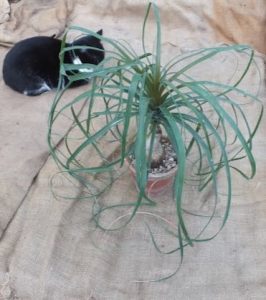
An excellent architectural plant for a frost free greenhouse or conservatory is the Pony-tail, Bottle or Elephant’s Foot palm. A corky trunk with an emerging mane of strange linear leaves makes this most striking and even more so when you notice the exceptionally wide base. Slow growing this relation of the better known Cordyline palms can eventually reach 30 feet high. Though luckily these will stay usefully compact for decades with no need for pruning, or much else for these really are low-maintenance plants.
Originally from Mexico this succulent has a huge spreading base from which it gets the name Elephant’s Foot. The trunk or trunks eventually terminate at their tops as veritable manes of narrow pendulous leaves which may hang down 6 feet or more. Becoming thin and wiry these are very attractive to pets especially cats who love to chew at them. Fortunately these leaves are not sharp edged or thorny and also tough enough to withstand such unwanted attentions.
The name has changed several times, originally Nolina recurvata it became Beaucharnia and now Beaucarnea. Which is a shame as the old name Nolina gave a lovely pnemonic of no-fall-over from the exceptionally wide base. There is a lovely example by the old entrance to the Botanic Gardens in Madeira which must have a base five times wider than it’s main trunk which then subdivides into a dozen or more each topped with a mane of green leaves.
In maturity the top will also erupt with massive flushes of tiny white scented flowers, again much resembling those of a Cordyline.
As this is a monotypic genus with no other species or varieties you could grow this from seed and it will come true. Though it will require some patience. A young plant is not expensive and is a good investment as it will give you decades of pleasure.
Beaucarneas require a well drained sandy compost in an earthenware container to give mass and solidity as those pets may well tug a plant over otherwise. Apart from freedom from frost they need little other guarding as these are seldom bothered by most pests or diseases. Watering and feeding need only be occasional and light. Indeed they do not like damp cold or wet feet but otherwise are remarkably tough and endure neglect better for longer than most plants.


